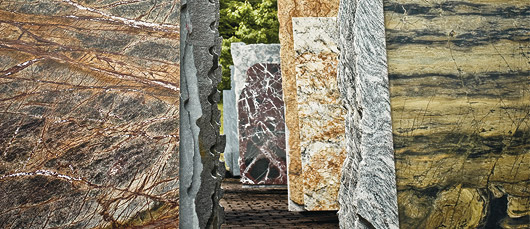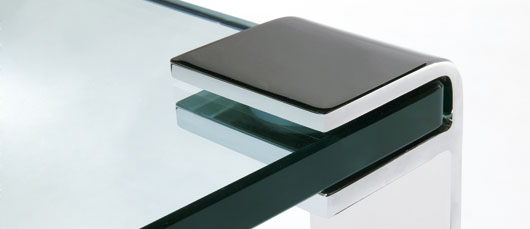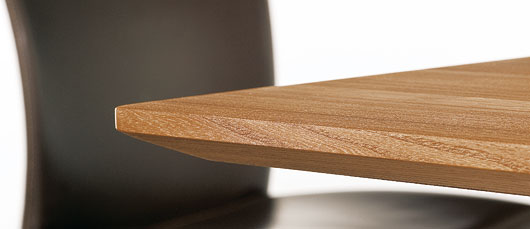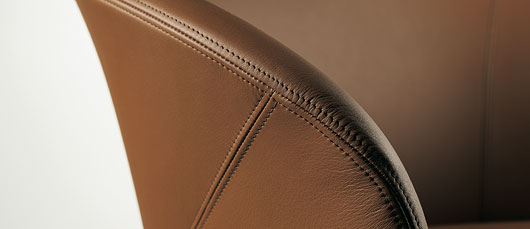Materials
Stone

For us, natural stone is like the page from a history book about our Earth. Forming as it did millions of years ago during the evolution of our planet it is found and worked today at enormous expense and effort in the world’s quarries.
Float glass

Float glass is an industrial product and is manufactured fully automatic on huge production lines (approximately 1.2 km long) at a melting temperature of approximately 1,600°C. Similar to the blast-furnace of the steel producers a glass melting plant is designed to continuously manufacture for 10-11 years. During this time tons of float glass plates are rolling off a conveyor without interruption, day by day and around the clock. They are commissioned, packaged und dispatched by lorry, rail or ship to the glass refinement industry. Here the cutting und work on the edges takes place.
For the tables with bevelled glass there is a special procedure for the ready plates in which they are reheated up to approximately 800°C until it is possible to bend them over special moulds. They then have to slowly cool down to retain the required shape.
These glass plates, manufactured with great technical effort, have therefore certain characteristics, which clearly deviate from normal float glass plates. The special features of these glass plates, especially in the curved areas, are: ripples, rainbow-coloured mirror reflexes, spot indentations, small bubbles or inclusions and fine lines. Slight irregularities can also be seen at the edges. The dimensional accuracy of height and width and the angles of the side walls are also influenced by the bending procedure. These special features are due to the manufacturing process and need to be understood and accepted as such.
DRAENERT opens up for the manufacture of glass tables the endless universe of colours by a new technology. With special glass lacquers, we combine the brilliance and clarity of glass with almost every required colour shade; also mirror glass is possible. To best preserve the colourfastness of the lacquers we use for this product line, exclusively, white glass as a carrier material, a clear glass with low iron oxide content, which, when looking through, stands out due to the missing green tinge. However, a light turquoise shade is visible at the edges. The edges of normal float glass tables are dark-green. In addition, a special adhesive technology enables, in connection with the glass lacquers, a continuous vision on the glass surface without interruption by glued-on metal parts. They, therefore, stay invisible.
General care instruction
There is not much to be said about the care of float glass. Float glass is both a user-friendly as well as a sensitive product, resistant to virtually all normal household acids and alkalis and easy to take care of with conventional non-abrasive cleaning agents. This is valid also for lacquered surfaces. As part of our range of care products, DRAENERT offers a special cleansing foam. Dull rings on the surface of the glass mostly come from lime deposits in water and can be easily removed with a non-abrasive de-scaling agent. However, glass can be easily scratched through mechanical influences or even break as a result of mishandling.
Some basic rules for using furniture with bevelled glass
Bevelled glass tables can take loads equivalent to conventional tables, but should not be loaded above the normal capacity.
Please never sit on bevelled glass tables.
Bevelled glass tables are not toys for children.
Glass must never be exposed to rapid temperature changes (e.g. hot or deep frozen items). This can result in a spontaneous fracture. Please use coasters.
Care should be taken with ceramics, porcelain or diamond rings as their very sharp edges can cause light scratches. Please use coasters.
Damage to edges can, after a while, lead to plate fracture with dangerous glass splinters.
Tables of a set which can be pushed under each other must be moved with great care. The hard glass edges may damage the lacquer.
Solid Wood

All organic life grows. It originates from a tiny germ cell and, undergoing various processes adapting it to the special conditions of its own environment, it develops its own unique form and characteristics. A tree is neither manmade nor produced synthetically, it cannot be reproduced or replaced at will, but comes into being as a synthesis of earth, water, air and light.
In the cultural history of mankind, solid wood is the material which best illustrates the distinctive growth lines of the life which surrounds us and is accordingly the material par excellence for the manufacture of furniture. Solid wood has its own unique features and appearance. Depending on the type of wood and its processing, its appeal varies in colour, markings and form. The gentle lines of the annual rings or the vivid graining play just as much a part as do the fine swirls, in-growths and small hard knots.
For our tabletops, we mainly use such native woods as maple (the pale variety as a standard), beech (the muted varieties as a standard), ash, European cherry, but also Swiss pear and American walnut. They are edge-glued with slats of varying widths.
Solid wood remains a living material. It works, i.e. it adjusts itself to the local climate. It expands or contracts according to warmth and humidity. This means that the joints between individual components could subsequently become visible. It can also change colour under the influence of sunlight. Lighter woods tend to become darker, darker woods to become paler. Although the reaction of the basic materials in wood to UV light can be delayed by modern varnishing systems, it cannot be fully prevented. These properties found in all solid wood furniture are a sign of its genuineness and highly typical for this traditional material used in furniture craftsmanship.
General care instructions
Beware of placing solid wood tables on underfloor heating or in continuous intensive sunlight (conservatory). For the above reasons, these sites cause extreme stress to solid wood furniture. Warping and significant colour changes could also occur. Our tables are sealed with high-quality, two-component varnishes and are greatly resistant to the usual household fluids and fats. They can be easily cleaned with a conventional, non-abrasive cleaning agent.
Care for your table by simply wiping it down with a mild soap solution and then dry with a soft cloth.
There are many materials in a household, which are harder than a lacquered surface and these can, therefore, scratch them. Special attention has to be paid to sharp, unglazed edges of ceramic and porcelain dishes. Please always use coasters or undermats.
All synthetic resin surfaces are sensitive to heat. Place hot pans always on a suitable mat. Otherwise, irreversible damage may be caused to the lacquer.
Oiled surfaces "breathe". They are not sealed with varnish which means they are more sensitive to all kinds of liquids. Through normal use and through oiling with DRAENERT Wood Oil (every 6 months), they will attain a natural patina which will make the surface relatively resistant.
Marks in the wood fibre can be treated as follows:
In case of polished surfaces: Polish in the direction of the fibres (stepwise with grain size 100-600) until the mark has disappeared. Afterwards, adjust the transitions over a large area. Next oil the immediate marked area once or twice; afterwards oil the whole surface.
For brushed surfaces: Brush the damaged area with a hard or brass bristle brush in the direction of the fibres until the mark has disappeared afterwards adjust transitions over a large area. Do not polish as this will give a different surface appearance. After this, proceed as described above.
Leather

Leather holds a prominent position in the range of classic natural materials, such as wool, cotton, silk or linen fabrics, in the upholsterer trade. The typical characteristics of skin and hide, from which leather is produced, remain unmistakable: They are characteristics like our own skin, such as tenderness, softness, warmth, elasticity. However, also robustness and toughness are signs of its nature and genuineness.
DRAENERT supplies 3 different leather collections:
Leather I is a high quality coated nappa leather from German and Austrian cattle hides. It is fully coloured and has a coloured top coating, which largely covers up the natural characteristics, like fattening folds, insect bites and skin injuries. Due to this, it becomes very hard-wearing, is easy to care for and to a great extent insensitive to light.
Leather II includes the whole Elmosoft® VI collection from Sweden. This is very supple and lightly pigmented semi-aniline leather in a wide range of colours (at present 42 shades). This leather has largely been left in its natural state. It shows the typical natural characteristics of a leather skin, like insect bites, fine scarred wounds and fattening folds as a sign of its genuineness. Semi-aniline leather needs thorough and regular care.
Bend leather is high-quality, coated cracked leather. It is dyed thoroughly and equipped with a coloured surface coating, which renders it very hard-wearing and easy to clean.
General Care Instruction
Do not expose leather to direct sunlight, as this would harm the colour and the leather tends to dry out quickly.
Ensure that humidity is not too low as dry leather tends to crack. (Please keep the furniture away from radiators).
Remove dust from the surface regularly by vacuuming or wiping with a damp soft cloth.
Dab off marks rather quickly with an absorbing cloth (Do not rub!). Possibly, moisten with weak neutral soapy water and rework by dabbing it on over a large area. Wash off with clean, distilled water and dry with a dry cloth. Remaining fat is absorbed into the leather after some time and evaporates.
We recommend using our leather care set – also standard leather cleaning and care agents may be used - after mark treatment, but also for regular care. This will maintain the elasticity of the leather, freshen up colours and improve or renew the mark protection. (Always test on a less visible location before use!!).
Never treat leather with aggressive cleaning agents, solvents, wax or shoe polish.
Also, we would like to point out a risk to especially light colours. As the present trend for living spaces selects mostly light and pastel colours, clothing fashion tends often to very dark shades. In this case, the customer must often accept materials which are not colourfast. The colour pigments could possibly, by only one contact, easily be transferred to the furniture covers. In the meantime, many clothes manufacturers point out this risk. These colour marks cannot be compared with a usual soiling. They are very stubborn and, because of their often unclear chemical composition, cannot be removed any more.




